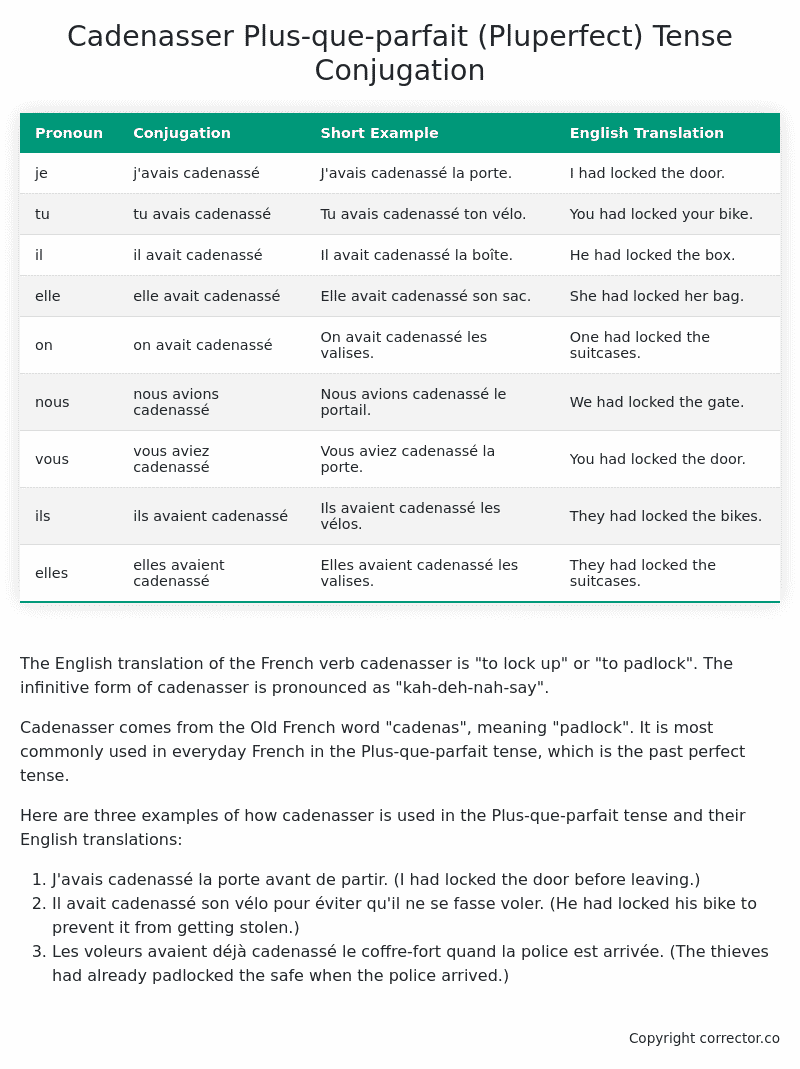Plus-que-parfait (Pluperfect) Tense Conjugation of the French Verb cadenasser
Introduction to the verb cadenasser
The English translation of the French verb cadenasser is “to lock up” or “to padlock”. The infinitive form of cadenasser is pronounced as “kah-deh-nah-say”.
Cadenasser comes from the Old French word “cadenas”, meaning “padlock”. It is most commonly used in everyday French in the Plus-que-parfait tense, which is the past perfect tense.
Here are three examples of how cadenasser is used in the Plus-que-parfait tense and their English translations:
- J’avais cadenassé la porte avant de partir. (I had locked the door before leaving.)
- Il avait cadenassé son vélo pour éviter qu’il ne se fasse voler. (He had locked his bike to prevent it from getting stolen.)
- Les voleurs avaient déjà cadenassé le coffre-fort quand la police est arrivée. (The thieves had already padlocked the safe when the police arrived.)
Table of the Plus-que-parfait (Pluperfect) Tense Conjugation of cadenasser
| Pronoun | Conjugation | Short Example | English Translation |
|---|---|---|---|
| je | j’avais cadenassé | J’avais cadenassé la porte. | I had locked the door. |
| tu | tu avais cadenassé | Tu avais cadenassé ton vélo. | You had locked your bike. |
| il | il avait cadenassé | Il avait cadenassé la boîte. | He had locked the box. |
| elle | elle avait cadenassé | Elle avait cadenassé son sac. | She had locked her bag. |
| on | on avait cadenassé | On avait cadenassé les valises. | One had locked the suitcases. |
| nous | nous avions cadenassé | Nous avions cadenassé le portail. | We had locked the gate. |
| vous | vous aviez cadenassé | Vous aviez cadenassé la porte. | You had locked the door. |
| ils | ils avaient cadenassé | Ils avaient cadenassé les vélos. | They had locked the bikes. |
| elles | elles avaient cadenassé | Elles avaient cadenassé les valises. | They had locked the suitcases. |
Other Conjugations for Cadenasser.
Le Present (Present Tense) Conjugation of the French Verb cadenasser
Imparfait (Imperfect) Tense Conjugation of the French Verb cadenasser
Passé Simple (Simple Past) Tense Conjugation of the French Verb cadenasser
Passé Composé (Present Perfect) Tense Conjugation of the French Verb cadenasser
Futur Simple (Simple Future) Tense Conjugation of the French Verb cadenasser
Futur Proche (Near Future) Tense Conjugation of the French Verb cadenasser
Plus-que-parfait (Pluperfect) Tense Conjugation of the French Verb cadenasser (this article)
Passé Antérieur (Past Anterior) Tense Conjugation of the French Verb cadenasser
Futur Antérieur (Future Anterior) Tense Conjugation of the French Verb cadenasser
Subjonctif Présent (Subjunctive Present) Tense Conjugation of the French Verb cadenasser
Subjonctif Passé (Subjunctive Past) Tense Conjugation of the French Verb cadenasser
Subjonctif Imparfait (Subjunctive Imperfect) Tense Conjugation of the French Verb cadenasser
Subjonctif Plus-que-parfait (Subjunctive Pluperfect) Tense Conjugation of the French Verb cadenasser
Conditionnel Présent (Conditional Present) Tense Conjugation of the French Verb cadenasser
Conditionnel Passé (Conditional Past) Tense Conjugation of the French Verb cadenasser
L’impératif Présent (Imperative Present) Tense Conjugation of the French Verb cadenasser
L’infinitif Présent (Infinitive Present) Tense Conjugation of the French Verb cadenasser
Struggling with French verbs or the language in general? Why not use our free French Grammar Checker – no registration required!
Get a FREE Download Study Sheet of this Conjugation 🔥
Simply right click the image below, click “save image” and get your free reference for the cadenasser Plus-que-parfait tense conjugation!

Cadenasser – About the French Plus-que-parfait (Pluperfect) Tense
Tense Formation
Common everyday usage patterns
Sequencing of past events
Background information
Hypothetical or reported speech
Interactions with other tenses
Summary
I hope you enjoyed this article on the verb cadenasser. Still in a learning mood? Check out another TOTALLY random French verb conjugation!


